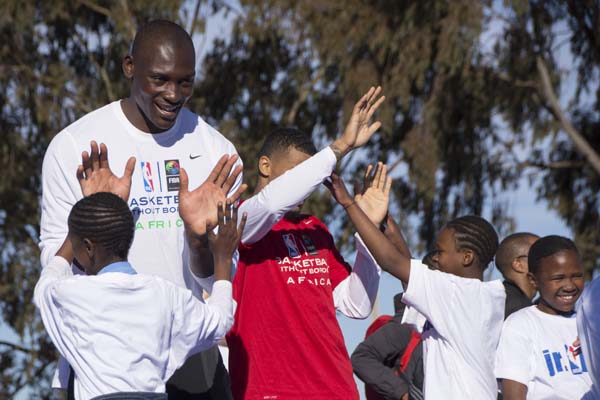The globalization of the United States-born sport began in 1893 and continues to this day through professionalization and diplomacy.
When basketball fans in the United States talk hoops outside of the NBA, NCAA, or any other domestic league, they usually center the conversation around three things: the Olympics, FIBA, or which international prospect might be the next Giannis Antetokounmpo. But the manner in which the sport grew to its current global state stretches back to the 1890s.
“I see basketball as one of these firstborn global sports,” said Lindsay Sarah Krasnoff.
Lindsay Sarah Krasnoff, a historian and journalist who’s in the process of completing a book tentatively titled Basketball Empire, has found that basketball’s presence in countries outside of the U.S. goes back to the sport’s beginning. And considering that the game was invented by a Canadian in the U.S., nearly 300 million people in China play basketball, and the world’s oldest court resides in a Paris YMCA, the sport could be considered just as much Canada, France or China’s as it is the United States’.
“I see basketball as one of these firstborn global sports,” Krasnoff said. “It was immediately spread within the first decade after it was invented in 1891. Because of that, where it was spread, each place developed their own basketball heritage and culture.”
Invented in 1891 by Canadian James Naismith, a 31-year-old graduate student at the time, in a gymnasium at Springfield College in Springfield, Massachusetts, the game quickly expanded overseas thanks to YMCA missionaries. At the time of the sport’s creation, Springfield College was also known as the International YMCA Training School and Naismith was a physical instructor tasked with developing a new game to keep a class of “unruly” boys busy. In an audio excerpt from a radio broadcast discovered by Dr. Michael J. Zogry, Naismith explained that the game had to be tweaked to ensure the boys wouldn’t hurt each other. To prevent tackling, he implemented a rule that whoever held the ball was not allowed to run with it, which might surprise some fans of today’s fast-paced version. Naismith’s original version of the sport also famously featured two peach baskets as goals for a soccer ball and stationed someone above the baskets to remove the ball after a made shot. As the game spread, however, many of Naismith’s original 13 rules evolved to turn the sport into what it is today.

By 1897, YMCA missionaries had introduced the sport, as part of their global expansion, to locals in France, Brazil, China, and Australia, among other countries. Over the next few decades, both religion and war spread the sport to different cultures throughout the world and the game was quickly adopted by those who had been unfamiliar with it.
Though the sport expanded globally before the turn of the century, the International Basketball Federation, or FIBB, wasn’t created until 1932. The game wasn’t played in the Olympics until the Summer Olympics in Berlin in 1936. And FIBB, which later became FIBA, didn’t host the first world championships until 1950 for men and 1953 for women. Argentina swept the first men’s world championship and defeated the U.S. in the finals, proving that although the game originated in the U.S., other countries had already developed enough skill to beat them.
In today’s world of basketball, most rankings of the best professional leagues lead with the caveat that the NBA’s collective talent makes it too good to be included. But in the 2019 FIBA Basketball World Cup, the U.S. infamously finished in seventh place out of 32 teams. It’s worth noting that the majority of top-tier NBA talent for the U.S. team, (i.e. LeBron James, Kawhi Leonard, Stephen Curry), sat out those most recent games. In addition, more than 50 NBA players participated in the tournament, but Spain, which won the title, featured only four NBA players.

Add to the U.S. team’s disappointing finish the fact that NBA rosters have featured at least 100 international players for six straight seasons, and it appears that the rest of the world is staying competitive. A review of each FIBA World Championship shows that the U.S. is tied with Yugoslavia for most gold medals at five apiece. If anything, the 2019 games made clear to the U.S. that it can’t expect to send non-superstar NBA players to international competitions and come away with a win. There’s a reason that the Dream Team, winner of the 1992 Olympics and widely regarded as the best team of all time, became just that – Hall of Fame-caliber players loaded its roster.
Before that 1992 Olympic run, FIBA had allowed only amateur players to participate in competitions. As professional basketball players continue to cross over from continent to continent, the global battle for the top of the basketball hierarchy intensifies by the day.
Until the COVID-19 pandemic hit, the NBA and FIBA’s newest joint venture, Basketball Africa League, was set to initiate in March before BAL President Amadou Gallo Fall announced its postponement. Krasnoff, who earned a doctorate in history from The Graduate Center (City University of New York), recently co-directed a basketball diplomacy project through SOAS University of London in relation to the BAL. She explained that one of her roles in the project was to interview people involved in the history of basketball in Africa as a way to conduct an oral chronicle in addition to gauging interest and input on the league itself and areas within diplomatic reach.
“So, using Basketball Africa League as one of the pegs that we would talk about, but you know, that it was a window into other issues such as education, overall development, economic growth, gender, and so forth,” Krasnoff said.

The BAL, NBA’s first professional league created outside of North America, was preceded by Basketball Without Borders, another joint program created by NBA and FIBA in 2001. BWB typically consists of a four-day camp filled with development of basketball fundamentals, community outreach, and life skills, often with NBA players involved. That program has led to 47 campers drafted by NBA teams with an additional four former campers signed as free agents.
From Naismith using basketball as a physical and educational tool at the YMCA to BWB building basketball infrastructure around the globe, it’s clear that basketball has always been tied to education. That’s one of the most noticeable cultural aspects of the worldwide sport that Krasnoff has picked up on through her research. She recalled a story from a former basketball coach, Carmine Calzonetti, which highlighted the good that can come from sports diplomacy.
In 1982, Calzonetti, who was at the time a St. John’s University basketball assistant coach, along with Richard Lapchick of the Phelps Stokes Fund, brought a group of Big East basketball student-athletes to Angola, which was in its seventh year of civil war. As the Big East conference’s all-star team played games in cities like Luanda and Huambo, the South African army agreed to cease bombing the cities in which the team played, so long as they were given a schedule ahead of time.
“So that is, I think, a really poignant example of how basketball is about much more than just a game,” Krasnoff said. “It cannot change the world, but it can certainly be a tool of facilitation.”
Header image courtesy of Tom Fisk/Pexels.



